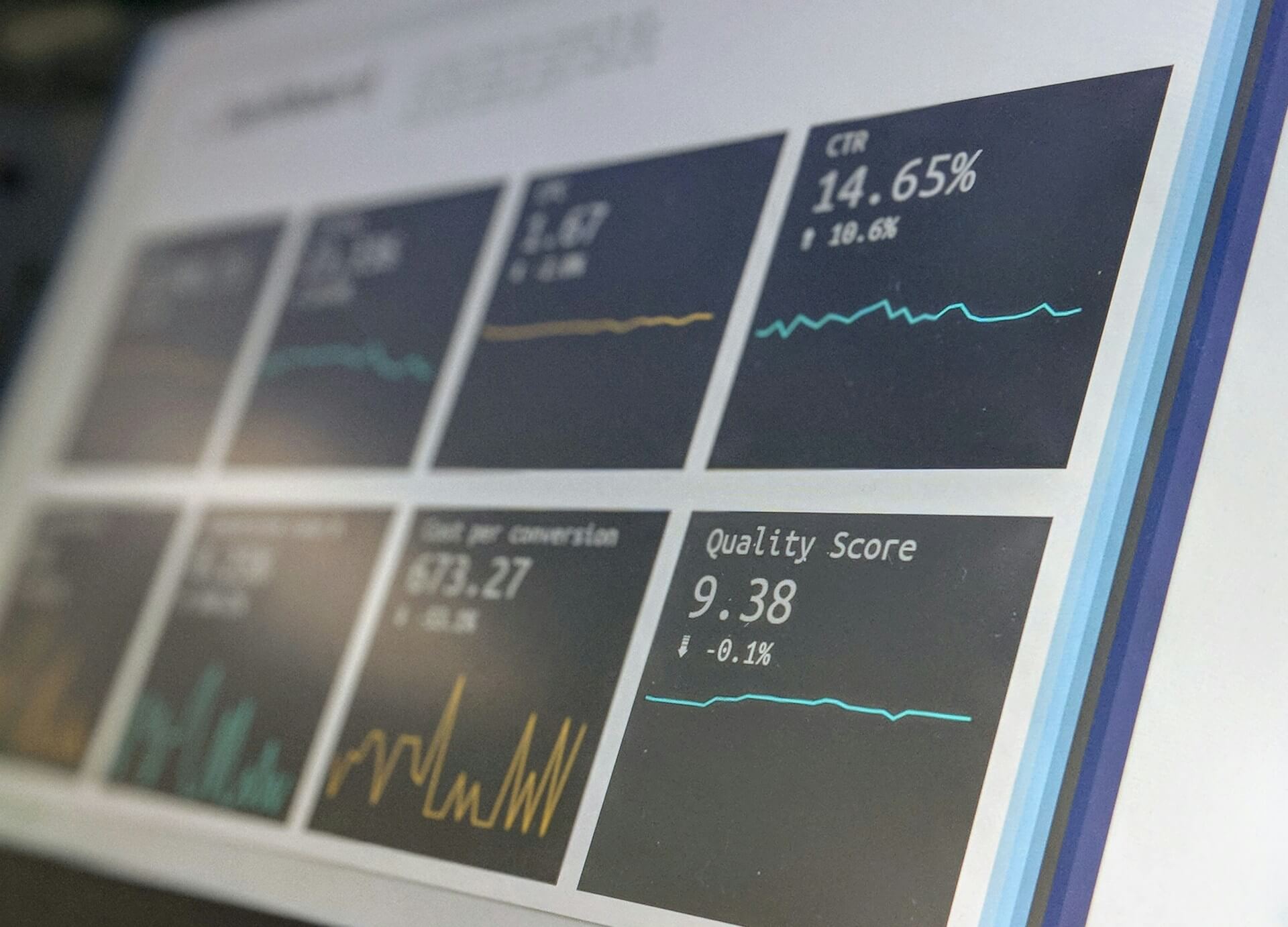
How to Create Stunning Project Status Reports in Confluence
Struggling to keep everyone updated on the project status? We’ll show you how to easily

Are you new to Atlassian and feel overwhelmed by Confluence macros overwhelming? Fear not!
This guide is your shortcut to mastering these powerful tools. Whether your Confluence pages need a touch of flair or a boost in collaboration, macros are here to help. But what exactly are macros in Confluence Cloud, how do you add them? Plus, what’s the deal with these shortcuts?
This ultimate guide has all the answers you need. We’ll explore what Confluence macros are, provide examples of some of the most popular ones, and offer step-by-step instructions on how to leverage them effectively. We’ll look exclusively at macros built for Confluence Cloud rather than Data Center.
Atlassian Confluence macros allow you to embed content, visualize data, automate tasks, and customize the appearance of your Confluence pages. Macros are designed to make your content more engaging, informative, and actionable, enabling you to create rich, interactive experiences for your team members.
Macros in Confluence Cloud are categorized based on their functionality, making it easy to find the right tool for the task at hand. Whether you need to embed a video, create a dynamic table, or integrate with external applications, there’s likely a Confluence macro available to meet your needs.

Now, let’s walk you through how to add macros and use them in your Confluence pages. There are two ways to do so, one leans more towards the graphically driven user, the other toward users who prefer keyboard shortcuts. The choice is yours.
First, simply navigate to the Confluence page and the specific area where you’d like to add the Confluence macro and enter Edit mode by selecting the pen icon in the editor toolbar.
For point-and-click users amongst us;
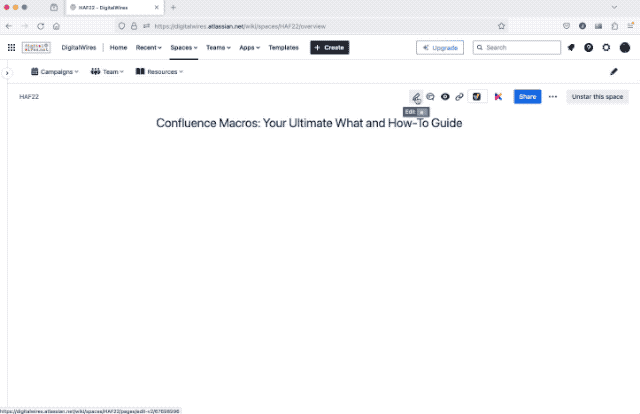
If shortcuts are more your thing, type the backslash character / to initiate the macro list and follow the same steps to insert it.
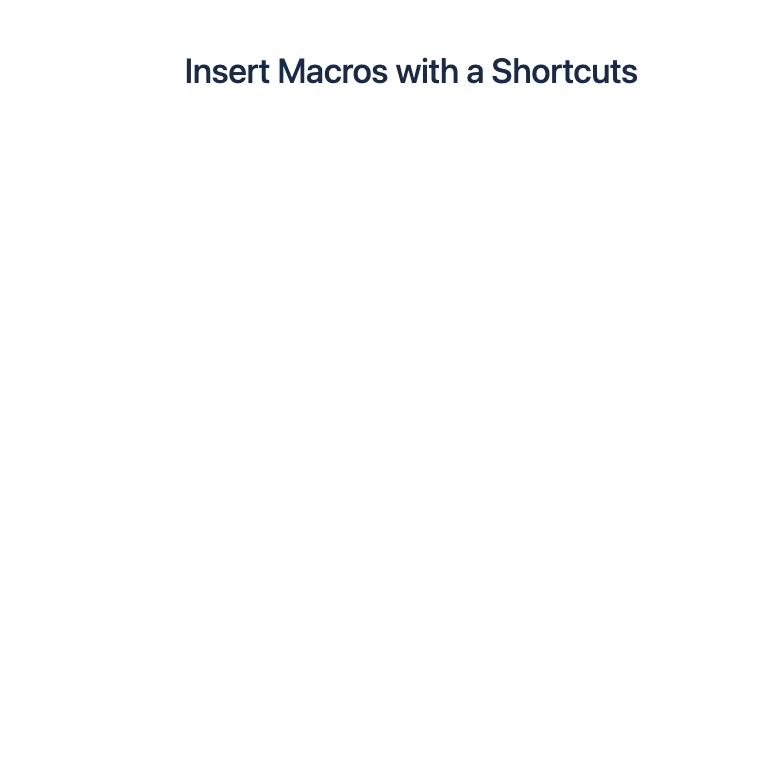
Whatever the choice, you’ll see there are a wide variety of macros to choose from, giving you a wide variety of options to enhance your Confluence page functionality.
There’s a wide variety of types of macros available in Confluence cloud, including the following;
You can find the full list of Confluence cloud and Confluence data Center macros on the Atlassian’s macro introduction. Yes, there are different macros available for cloud and data center, in this article, we’ll explain how to use them in the cloud.
We’re not going to address them all; however, we will touch on the following (most popular) macros; Attachments, Panels, Status, Charts, Anchors, and Jira Issues.
The Attachments macro is an effective and convenient way to display a list of files attached to a specific Confluence page, whether that be the current page you’re on or another page within your instance. When you need to provide quick, ready access to project files, forms and templates, or images and diagrams, this is an invaluable tool.
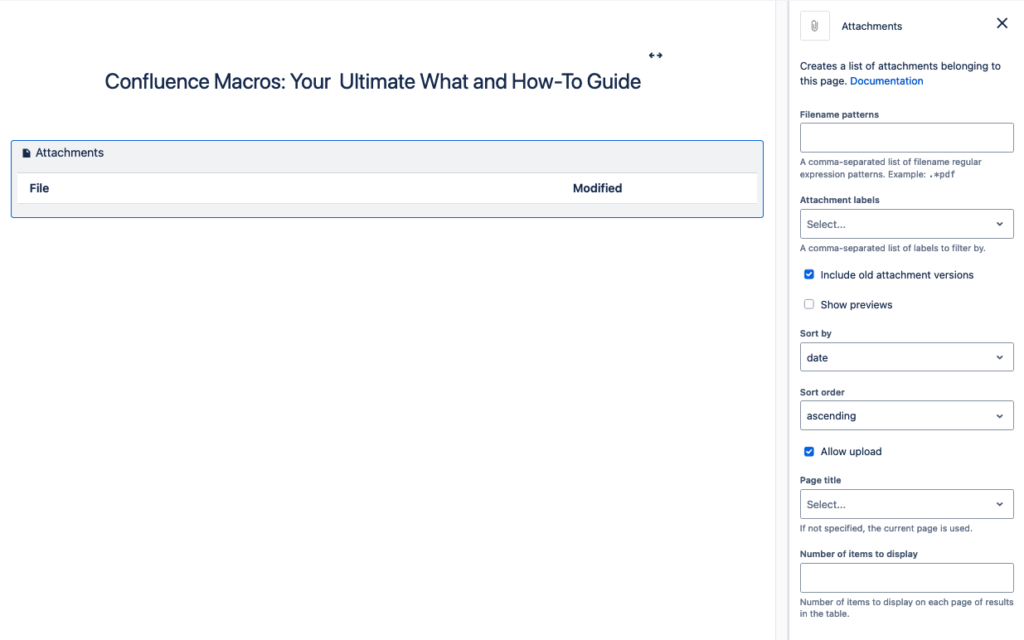
Additionally, there are a number of properties you can set for the macro that will add even greater functionality based on the types of attachments you would like to display for the user;

The Panel macro is effective for highlighting text in Confluence, or to calling out specific pieces of information with a customizable, colored panel. There are similar macros (Info, Tip, Note, Warning) however the Panel macro gives you complete control over display features such as the background color, boarder, title, and text colors.

Giving you the ability to break up the look of your Confluence page and call attention to a specific topic of interest, the Panel macro can be used in page layouts or even table cells themselves.
As with the Panel macro, a Status macro can be added within the page layout or within a table cell. It can be used to highlight the status of a project or task, or indicate any sort of progress of level. As you can flexibly design the text in the status macro, you can also use the macro for other types of markup, such as labels.
In the table below, the Status macro is used to indicate which option has been selected, level of effort, and estimated costs. It’s used in conjunction with the Table macro as well as Emjoi macro.
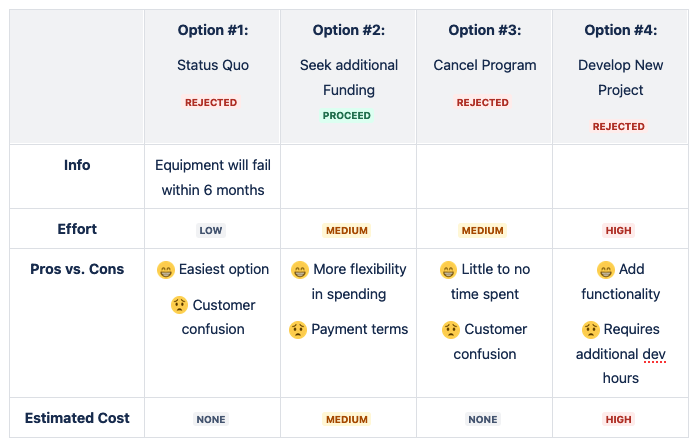
The Charts macro offers a great deal of flexibility and customization to best graphically represent the data you want.
In the example below, we’ve created a table of data we would like to visualize. In Edit mode, we select the Confluence table, and in the options provided below the selected table, we select the Insert chart option.

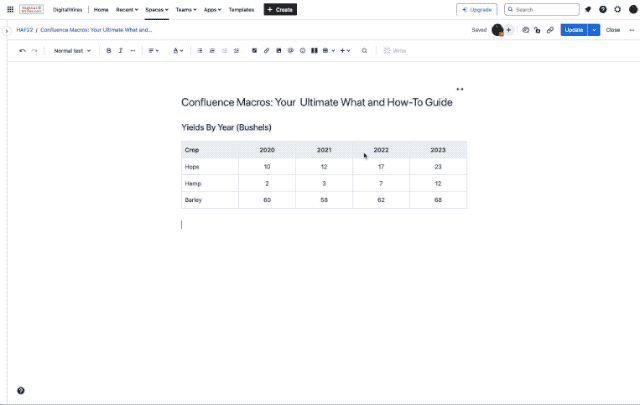
You have the ability to customize everything from the chart type, orientation, opacity, chart title, x and y-axis titles, legends, and much more in the Chart Options. To note, as data is updated in the table the chart is based upon, the chart automatically updates to reflect the new data.
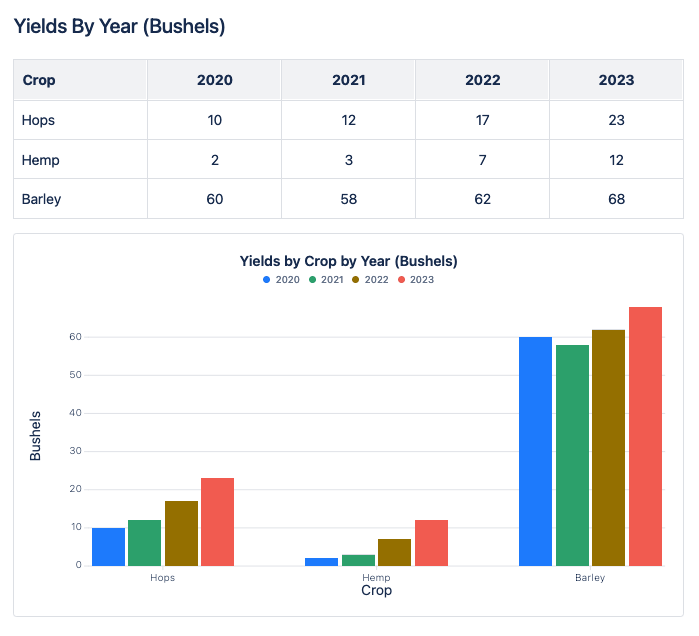
The Anchor macro is a very useful navigation tool. It helps move your viewers through the Confluence page from one area to another, or to other Confluence pages or even external web pages.
Particularly helpful on long pages, anchors can guide the reader from the top to a specific area further down. Then, they can easily navigate back to the beginning to explore other sections of the page.
In the example below, we placed an anchor macro at the bottom of the Confluence page. We named it page-end (the macro will insert dashes if there is space in the name) and then went to the top of the page where we had text we then added the hyperlink for the anchor we created.
NOTE: When you link to an anchor, preface the name of the anchor with “#” to signify it is an anchor destination.

The last Confluence macro we will discuss is the Jira Issues macro. If you’re using Confluence within your team or organization, it’s likely that you’re also using Atlassian’s Jira for ticketing and the planning of projects and tasks.
The macro gives you the ability to display a single Jira issue, a list of issues, or a count, based on a JIRA Query Language (JQL) search, filter, or URL. This works extremely well for project status updates, retrospectives and team meetings, and for generally sharing updates with those in your organization who are not regular Jira users.
To note, before you can use this macro, your Confluence and Jira application must be connected via Application Links. The level of sophistication for pulling data from Jira is really limited only by one’s knowledge of Jira, and more specifically, Jira Query Language (JQL).
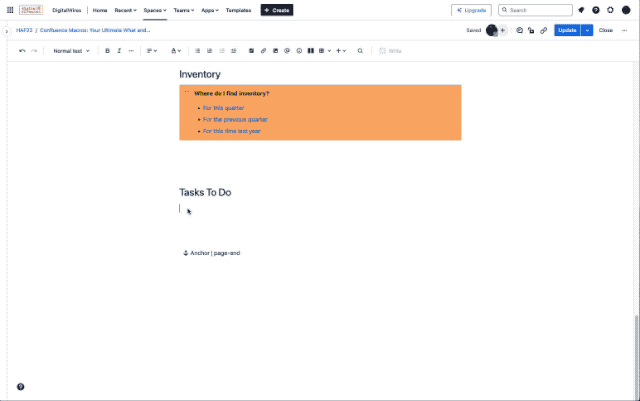
In our example, we selected the specific Jira project we wanted to display, filtered the type to only show “Tasks” with a status of “To do” and once we published our page, we had the respective information from Jira that we wanted.
Thus far, we’ve explored a number of Confluence’s built-in or native macros, and they certainly afforda great deal of additional functionality. However,there are times, especially when aiming to enhance the standard appearance of Confluence pages, when the default macros might not suffice.
Into this void steps Aura Content Formatting Macros from appanvil. Aura isn’t just one macro, it’s a full suite of 17 formatting macros for Confluence cloud. With everything from customizable buttons, cards, panels, dividers, and more, you can create highly appealing and engaging content. Using WYSIWYG (What You See Is What You Get) page creation, either from scratch or from hundreds of templates, it’s simply drag-and-drop to achieve a new level of creativity in Confluence.

The level of customization in Aura for formatting text is second to none. Everything aspect from the font weight, alignment, size, font style, and color (even with gradients) is customizable.
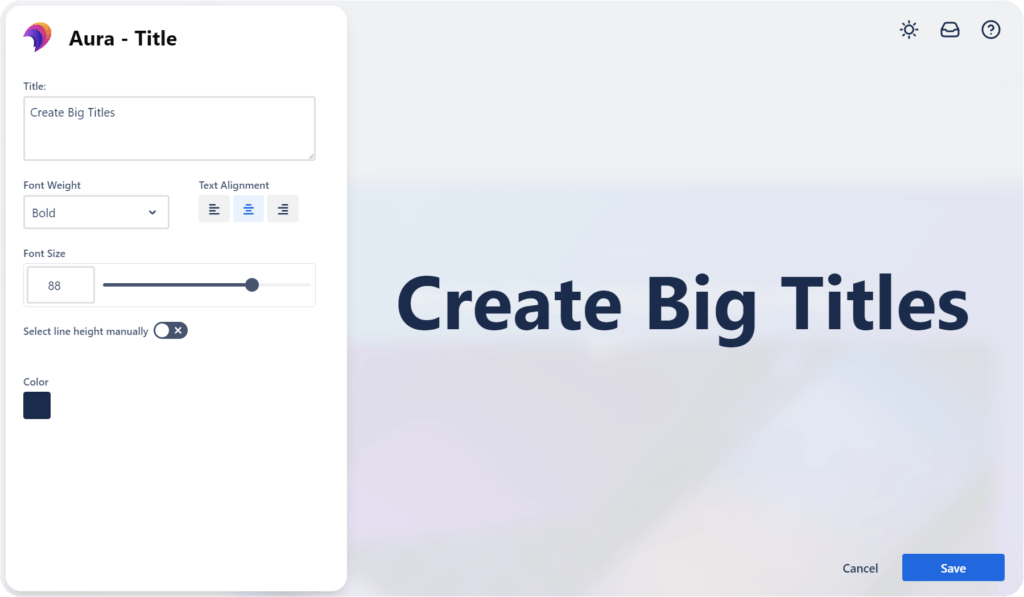
In particular to note is Aura’s Background Content Macro which, as the developers so eloquently put it, “enhances your pages by enabling the addition of background images, colors, or a blend of both. Seamlessly embed content and macros within these backgrounds to create visually compelling sections.”

To read more about Aura’s extensive dynamic content updatingformatting capabilities, head on over to the Atlassian Community article, “Don’t Waste Another Minute: Automate Content Updates in Confluence!”.
We’ve come up with ten “Pro Tips” to help you master using and adding Confluence macros. We hope these, along with the guidance we’ve provided thus far, will take your Confluence pages to the next level!
And your +1 pro tip – explore the Atlassian Marketplace, read the user reviews and ratings. You can learn a great deal about the practical use and performance of macros by those who’ve done more than just “kicked the tires”. They’ve dived in, they’ve experienced the good and the bad, they’ve shared the experiences (and frustrations) with the community and the developers. Take advantage of this resource as it’ll only benefit you, your teams, and your entire organization for the better!

We hope this has given you some real, applicable information and insights into the power and expandability that Confluence macros offer, with some real-world examples. There are a wide variety of macros included with your Confluence instance, and you can take advantage of those right away. And there are a handful of third-party macros like Aura that offer a complete suite of formatting tools unlike any others.
You’ve got nothing to lose and everything to gain by exploring the possibilities that await you in this fantastic world of Confluence macros.
Supercharge your Confluence

Struggling to keep everyone updated on the project status? We’ll show you how to easily

Tired of endlessly scrolling through Confluence to find what you need? We’ll show you how

The right intranet can make the difference if you thrive your simply survive. We’ll show

You are currently viewing a placeholder content from Wistia. To access the actual content, click the button below. Please note that doing so will share data with third-party providers.
More Information